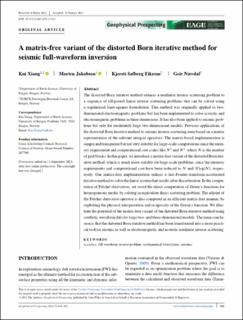| dc.contributor.author | Xiang, Kui | |
| dc.contributor.author | Jakobsen, Morten | |
| dc.contributor.author | Eikrem, Kjersti Solberg | |
| dc.contributor.author | Nævdal, Geir | |
| dc.date.accessioned | 2024-02-13T13:05:10Z | |
| dc.date.available | 2024-02-13T13:05:10Z | |
| dc.date.created | 2023-01-26T11:37:34Z | |
| dc.date.issued | 2023 | |
| dc.identifier.issn | 0016-8025 | |
| dc.identifier.uri | https://hdl.handle.net/11250/3117318 | |
| dc.description.abstract | The distorted Born iterative method reduces a nonlinear inverse scattering problem to a sequence of (ill-posed) linear inverse scattering problems that can be solved using a regularized least-squares formulation. This method was originally applied to two-dimensional electromagnetic problems but has been implemented to solve acoustic and electromagnetic problems in three dimensions. It has also been applied to seismic problems but only for moderately large two-dimensional models. Previous applications of the distorted Born iterative method to seismic inverse scattering were based on a matrix representation of the relevant integral operators. The matrix-based implementation is simple and transparent but not very suitable for large-scale computations since the memory requirement and computational cost scales like N2 and N3, where N is the number of grid blocks. In this paper, we introduce a matrix-free variant of the distorted Born iterative method, which is much more suitable for large-scale problems, since the memory requirements and computational cost have been reduced to N and Nlog(N), respectively. Our matrix-free implementation utilizes a fast-Fourier-transform-accelerated iterative method to solve the linear system that results after discretization. In the computation of Fréchet derivatives, we avoid the direct computation of Green's functions for heterogeneous media, by solving an equivalent direct scattering problem. The adjoint of the Fréchet derivative operator is also computed in an efficient matrix-free manner, by exploiting the physical interpretation and reciprocity of the Green's function. We illustrate the potential of the matrix-free variant of the distorted Born iterative method using synthetic waveform data for large two- and three-dimensional models. The main conclusion is that the distorted Born iterative method has been transformed into a more practical tool for seismic as well as electromagnetic and acoustic nonlinear inverse scattering. | en_US |
| dc.language.iso | eng | en_US |
| dc.publisher | Wiley | en_US |
| dc.rights | Attribution-NonCommercial-NoDerivatives 4.0 Internasjonal | * |
| dc.rights.uri | http://creativecommons.org/licenses/by-nc-nd/4.0/deed.no | * |
| dc.title | A matrix-free variant of the distorted Born iterative method for seismic full-waveform inversion | en_US |
| dc.type | Journal article | en_US |
| dc.type | Peer reviewed | en_US |
| dc.description.version | publishedVersion | en_US |
| dc.rights.holder | Copyright 2023 The Author(s) | en_US |
| cristin.ispublished | true | |
| cristin.fulltext | original | |
| cristin.qualitycode | 1 | |
| dc.identifier.doi | 10.1111/1365-2478.13323 | |
| dc.identifier.cristin | 2115506 | |
| dc.source.journal | Geophysical Prospecting | en_US |
| dc.source.pagenumber | 431-442 | en_US |
| dc.relation.project | Norges forskningsråd: 267769 | en_US |
| dc.identifier.citation | Geophysical Prospecting. 2023, 71 (3), 431-442. | en_US |
| dc.source.volume | 71 | en_US |
| dc.source.issue | 3 | en_US |

